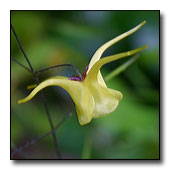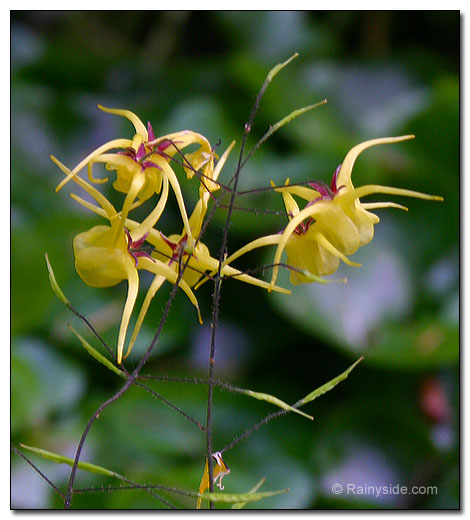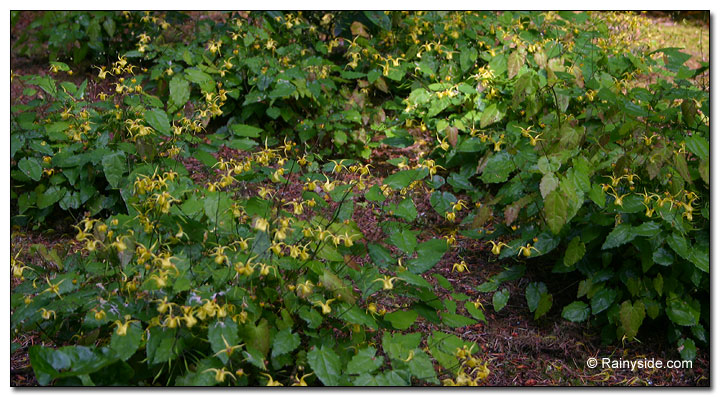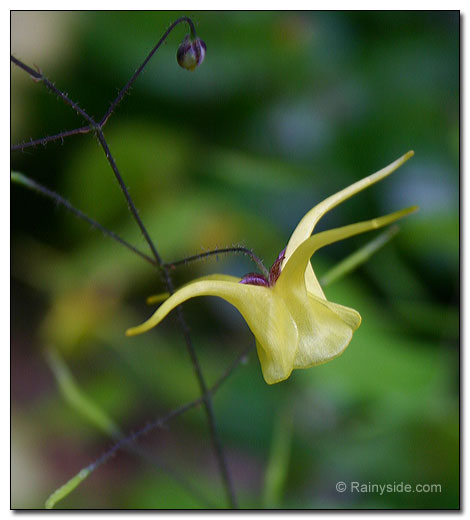Epimedium davidii
BISHOP'S HAT, BISHOP'S MITRE
Family: Berberidaceae
Pronounced: ep-ee-MEE-dee-um day-vid-EE-eye

Quick Jumps
Growing Guide
Rainy Side Notes
GROWING GUIDE

Origin:
Western China.
Plant Group:
Perennial.
Hardiness:
Sunset zones: 2-9, 14-17.
USDA zones: 5-9.
Heat zones: 9-4.
Mature size:
Height: 12 inches (15-30 cm).
Width: 18 inches (45 cm).
Flowering period:
Mid spring to early summer.
Flowering attributes:
Flowers are born on 12-24 inch tall stems, which typically carry a series of two flowers opposite of each other. The flowers have yellow sepals with red inner-sepals and long downward-curved spurs.
Leaf attributes:
Evergreen, narrow to broadly ovate, heart-shaped, green leaves with tufts of reddish hairs at the nodes. Young leaves are copper colored, changing to green as the leaf matures.
Growth habit:
Clump-forming.
Light:
Partial to full shade.
Soil:
Humus rich, fertile, moist soil, the plant typically grows on seepages on limestone cliffs.
Propagation Methods:
Sow seed as soon as ripe and place in cold frame.
Divide in autumn or after flowering.
Pruning Methods:
Shear plants back to the ground in late winter, to see the flowers above the foliage.
Rainy Side Notes


Many Epimediums are recommended for dry shade conditions. Not this one! In its native habitat, it's found growing on moist, limestone cliffs or next to streams. Epimedium davidii is a native of western Sichuan Province, P.R. China. The species will tolerate our acidic soils, even though it grows on limestone cliffs.
The demure species spreads slowly, eventually reaching two feet across in five years. A mass planting of this charming perennial, under trees or shrubs, makes an appealing effect. Its main flush of blooms is in mid spring to early summer; however, by keeping your plants well-watered and rich in organic matter, you will be rewarded with flowers throughout the season.
The small perennial is named after Pére Armand David (1826-1902) who went to China as a Lazurus missionary where he collected animals, insects and plants. An interesting side note, David was the first westerner to learn about the Giant Panda when he was given the skin of one, although he never saw a live one. In 1869, he collected many new plants including Epimedium davidii from Baoxing (Moupin) China.


Gardening for the Homebrewer: Grow and Process Plants for Making Beer, Wine, Gruit, Cider, Perry, and More
By co-authors Debbie Teashon (Rainy Side Gardeners) and Wendy Tweton
Copyright Notice | Home | Search | Perennials

